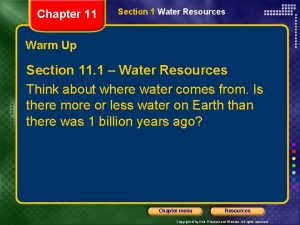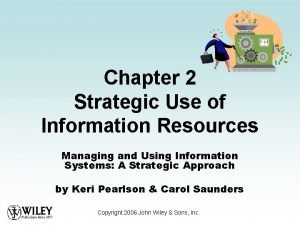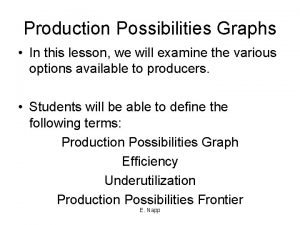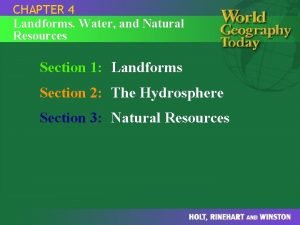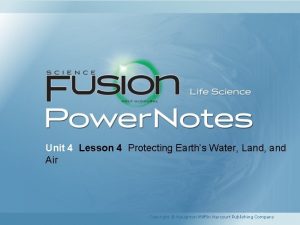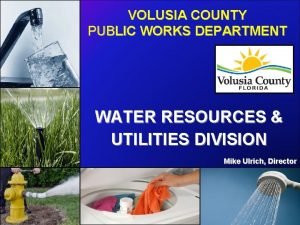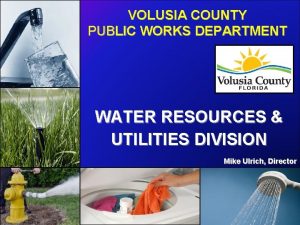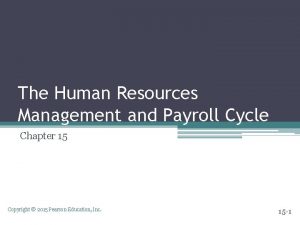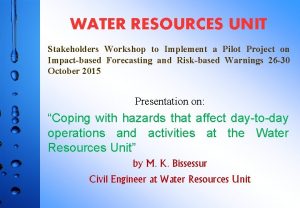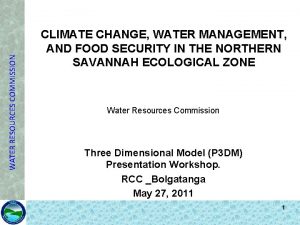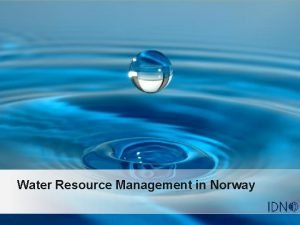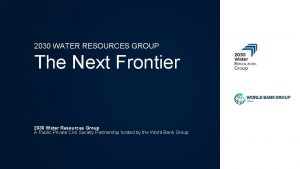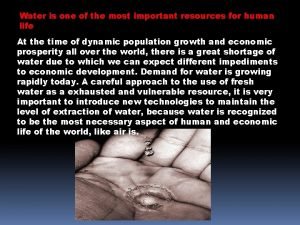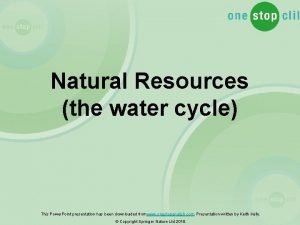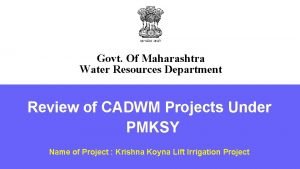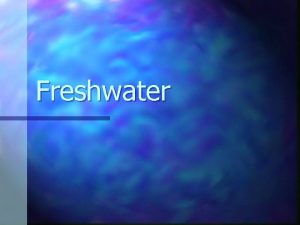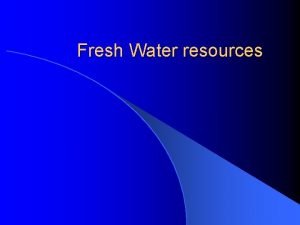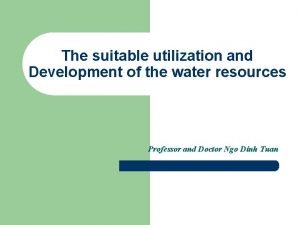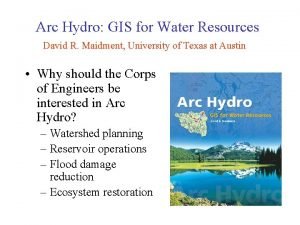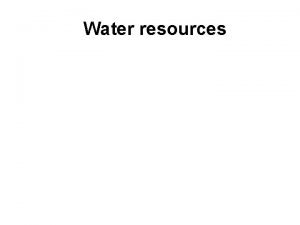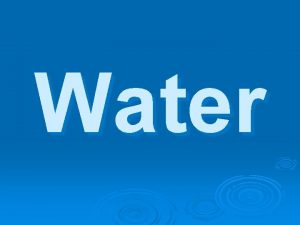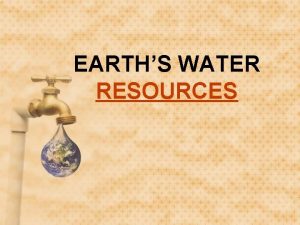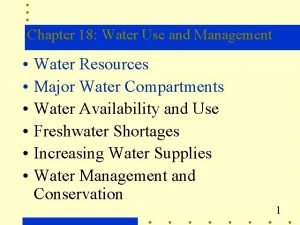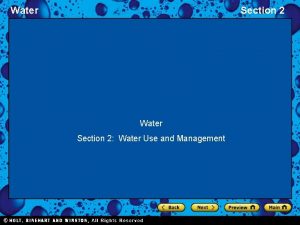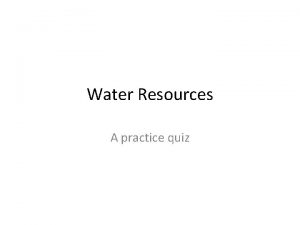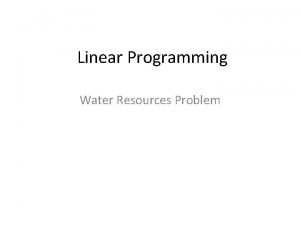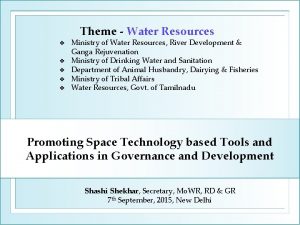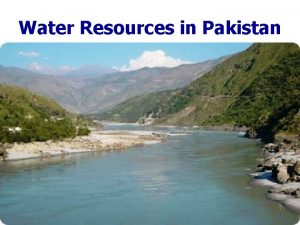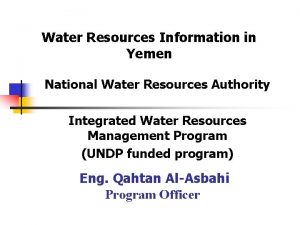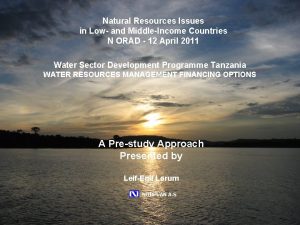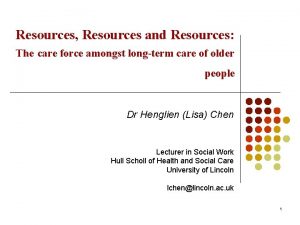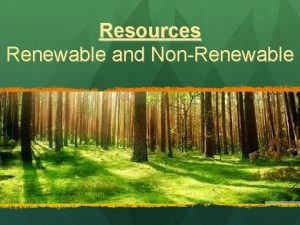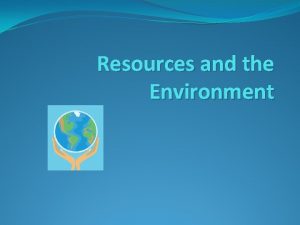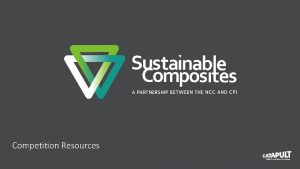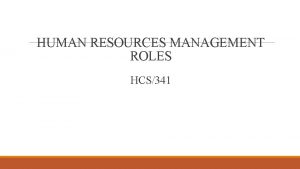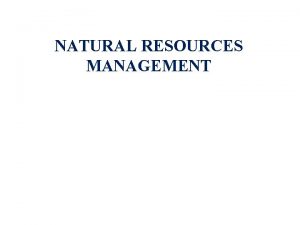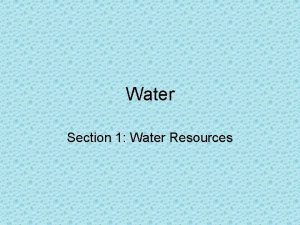Water Use and Management WATER RESOURCES Water all








































- Slides: 40

Water Use and Management

WATER RESOURCES • Water (all states) covers more than 70% of world’s surface.

Hydrologic Cycle

Hydrologic Cycle • Solar energy drives the hydrologic cycle by evaporating surface water. – Evaporation - Changing liquid to a vapor below its boiling point. – Sublimation - Changing water between solid and gaseous states without ever becoming liquid.

Hydrologic Cycle • Humidity - Amount of water vapor in the air. – Saturation Point - When a volume of air contains as much water vapor as it can hold at a given temperature. – Relative Humidity - Amount of water vapor in the air expressed as a percentage of the maximum amount that can be held at that temperature.

Hydrologic Cycle • Dew Point - Temperature at which condensation occurs for a given amount of water. – Cloud Condensation Nuclei (CCN) - Tiny particles that facilitate condensation. • Smoke, dust, sea salt, spores, sulfate aerosols (remember Air Pollutants)

Major Water Compartments • Glaciers, Ice, and Snow – 2. 6% of world’s water is classified fresh. – 0. 5 % is groundwater • 0. 014% readily accessible freshwater (lakes, rivers, groundwater). – As recently as 18, 000 years ago, one-third of continental landmasses were covered by glacial ice sheets. • Now, Antarctic glaciers contain nearly 85% of all ice in the world. – Sea ice comes from ocean water, but salt is excluded during freezing.

• http: //video. nationalgeographic. com/video/player/ environment/going-green-environment/greenhome-makeover/conserve-water-greenguide. html

MAJOR WATER COMPARTMENTS Oceans – Together, oceans contain more than 97% of all liquid water in the world. • Contain 90% of world’s living biomass. • Moderate earth’s temperature. – Average residence time of water in the ocean is between 100 days to 3, 000 years. (range)

Major Water Compartments • Groundwater- water below the water table – Second largest reservoir of fresh water. • Infiltration - Process of water percolating through the soil and into fractures and permeable rocks. – Zone of Aeration - Upper soil layers that hold both air and water. – Zone of Saturation - Lower soil layers where all spaces are filled with water. • Water Table - Top of Zone of Sat.

Groundwater

Groundwater • Aquifers - Porous layers of sand, gravel, or rock lying below the water table. (can be drained) – Artesian - Pressurized aquifer intersects the surface. (Water flows without pumping) • Recharge Zone - Area where water infiltrates into an aquifer. – Recharge rate is often very slow. • Presently, groundwater is being removed faster than it can be replenished in many areas.

Groundwater & Aquifers

Balancing the Water Budget • Oceans account for 86% of total evaporation. – Ninety percent of water evaporated from the ocean falls back on ocean as rain. • Remaining 10% is carried by prevailing winds over continents.

WORLD'S TEN LARGEST LAKES (IN TERMS OF SURFACE AREA) Name and location Area mi 2 Area km 2 Volume km 3 Read more: http: //www. waterencyclopedia. com/Hy-La/Lake-Formation. h Caspian Sea (saltwater) Turkmenistan, Kazakhstan, Russia, Azerbaijan, Iran tml#ixzz 0 UIb 52 wv 1 149, 200 386, 400 78, 200 Lake Superior (largest freshwater lake) United States, Canada 31, 700 82, 100 12, 230 Lake Victoria Kenya, Tanzania, Uganda 26, 828 69, 485 2, 700 Lake Huron United States, Canada 23, 000 59, 600 3, 537 Lake Michigan United States 22, 300 57, 800 4, 920 Lake Tanganyika Burundi, Tanzania, Zaire, Zambia 12, 700 32, 900 18, 900 Lake Baikal Russia 12, 200 31, 500 22, 995 Great Bear Lake Northwest Territories, Canada 12, 028 31, 153 2, 381 Lake Malawi (formerly Lake Nyasa) Malawi, Mozambique, Tanzania 11, 430 29, 604 6, 141 Aral Sea (saltwater) Kazakhstan, Uzbekistan 11, 200 (in 28, 687 (in 181 (in 1989), 1998), was was 1, 040 (in 26, 500 (in 68, 000 (in 1960)

Major Water Compartments • Wetlands – Play a vital role in hydrologic cycle. • Lush plant growth stabilizes soil and retards surface runoff, allowing more aquifer infiltration. – Disturbance reduces natural waterabsorbing capacity, resulting in floods and erosion in wet periods, and less water flow the rest of the year.

Major Water Compartments • The Atmosphere – Among the smallest water reservoirs. • Contains < 0. 001% of total water supply. • Has most rapid turnover rate. • Provides mechanism for distributing fresh water over landmasses and replenishing terrestrial reservoirs.

WATER AVAILABILITY AND USE • Renewable Water Supplies – Made up of surface runoff and infiltration into accessible freshwater aquifers. • About two-thirds of water carried in rivers and streams annually occurs in seasonal floods too large or violent to be stored effectively for human use. – Readily accessible, renewable supplies are 400, 000 gal /person/year.

Rainfall and Topography • Mountains act as cloud formers and rain catchers. – Air sweeps up the windward side of a mountain, pressure decreases, and the air cools. • Eventually saturation point is reached, and moisture in the air condenses. – Rain falls on the mountaintop. • Cool, dry air descends and warms, absorbing moisture from other sources. (Rain Shadow)

Rainfall and Topography Mount Waialeale – Kaua’i in Hawaii

Drought Cycles • Every continent has regions of scarce rainfall due to topographic effects or wind currents. – Water shortages have most severe effect in semiarid zones where moisture availability is the critical factor in plant and animal distributions. • US seems to have 30 year drought cycle. – Climatic changes such as global warming may alter cycles.

Types of Water Use • Withdrawal - Total amount of water taken from a source. • Consumption - Fraction of withdrawn water made unavailable for other purposes (Not returned to its source). – Degradation - Change in water quality due to contamination making it unsuitable for desired use.

Types of Water Use • Worldwide, humans withdraw about 10% of total annual renewable supply. – Many societies have always treated water as an inexhaustible resource. • Natural cleansing and renewing functions of hydrologic cycle do not work properly if systems are overloaded or damaged.

Quantities of Water Used • Human water use has been increasing about twice as fast as population growth over the past century. – Average amount of withdrawn worldwide is about 170, 544 gal/person/year. – Annual renewable water supply in US amounts to an average of 2. 4 million gallons/person/year. • Now withdraw one-fifth of this amount.

Global Water Use Growth

Water Use By Sector • Worldwide, agriculture claims about 69% of total water withdrawal. – In many developing countries, agricultural water use is extremely inefficient and highly consumptive. • Worldwide, industry accounts for about 25% of all water use. – Cooling water for power plants is single largest industrial use.

FRESHWATER SHORTAGES • Estimated 1. 5 billion people lack access to an adequate supply of drinking water. – Nearly 3 billion lack acceptable sanitation. • A country where consumption exceeds more than 20% of available, renewable supply is considered vulnerable to water stress. – Globally, water supplies are abundant, but, along with capital resources, are unevenly distributed.

A Precious Resource • Currently, 45 countries, most in Africa or Middle East, are considered to have serious water stress, and cannot meet the minimum essential water requirements of their citizens. – More than two-thirds of world’s households have to retrieve water from outside the home. • Sanitation levels decline when water is expensive.

Depleting Groundwater • Groundwater is the source of nearly 40% of fresh water in the US. – On a local level, withdrawing water faster than it can be replenished leads to a cone of depression in the water table, • On a broader scale, heavy pumping can deplete an aquifer. – Ogallala Aquifer • Mining non-renewable resource.

Depleting Groundwater • Withdrawing large amounts of groundwater in a small area causes porous formations to collapse, resulting in subsidence. – Sinkholes form when an underground channel or cavern collapses. – Saltwater intrusion can occur along coastlines where overuse of freshwater reservoirs draws the water table low enough to allow saltwater to intrude.

Saltwater Intrusion

INCREASING WATER SUPPLIES • Seeding Clouds – Condensation Nuclei (addition of chemicals) • Towing Icebergs – Cost • Desalination – Most common methods are distillation and reverse osmosis. • Three to four times more expensive than most other sources.

Increasing Water Supplies • Dams, Reservoirs, Canals and Aqueducts – Common to trap excess water in areas of excess and transfer it to areas of deficit. – Environmental Costs • Upsets natural balance of water systems. – Ecosystem Losses • Loss of wildlife habitat. – Reservoir Size – Water Quality

Dams, Reservoirs, Canals and Aqueducts – Displacement of People • Three Gorges Dams in China will force relocation of over a million people. (Yangtze’s River) – Evaporation, Leakage, Siltation • Evaporative losses from Lake Mead and Lake Powell on the Colorado River is about 1 km 3 per year (264 billion gallons). • Dams slow water flow, allowing silt (nutrients) to drop out. – Loss of Free-Flowing Rivers

WATER MANAGEMENT AND CONSERVATION • Watershed Management – Watershed - All the land drained by a stream or river. • Retaining vegetation and ground cover helps retard rainwater and lessens downstream flooding. – Additionally, retaining crop residue on fields reduces flooding and minimizing plowing and forest cutting on steep slopes protects watersheds.

Typical US Household Water Use

Price Mechanisms and Water Policy • Through most of US history, water policies have generally worked against conservation. – In well-watered eastern states, water policy was based on riparian use rights. – In drier western regions where water is often a limiting resource, water law is based primarily on prior appropriation rights. • Fosters “Use it or Lose it” policies.

Price Mechanisms and Water Policy • In most federal reclamation projects, customers were only charged for immediate costs of water delivery. – Dam and distribution system costs were subsidized. • Growing recognition that water is a precious and finite resource has changed policies and encouraged conservation across the US.


GIARDIA - bacterial Cholera - bacteria
 Uses of personal resources
Uses of personal resources Personal effectiveness meaning
Personal effectiveness meaning Water and water and water water
Water and water and water water The transformation process in operations management
The transformation process in operations management Differentiate fixed resources and variable resources
Differentiate fixed resources and variable resources Name 3 points
Name 3 points Renewable vs nonrenewable resources worksheet
Renewable vs nonrenewable resources worksheet Sweden and norway use equal quantities of resources
Sweden and norway use equal quantities of resources Chapter 11 section 2 water use and management
Chapter 11 section 2 water use and management Strategic use of information resources
Strategic use of information resources Strategic use of information resources
Strategic use of information resources A graph that shows alternative ways to use resources
A graph that shows alternative ways to use resources All resources are tightly coupled in computing paradigm of
All resources are tightly coupled in computing paradigm of Distributed system models in cloud computing
Distributed system models in cloud computing Natural resources from landforms
Natural resources from landforms Air and water resources lesson 4
Air and water resources lesson 4 Volusia county water
Volusia county water Volusia county water department
Volusia county water department Human resources and job design
Human resources and job design Human resource management exam paper
Human resource management exam paper Resources and capabilities in strategic management
Resources and capabilities in strategic management The human resources management and payroll cycle
The human resources management and payroll cycle Yesterday
Yesterday They spent all day swimming and sunbathing at the beach
They spent all day swimming and sunbathing at the beach 1012069
1012069 Water resources unit mauritius
Water resources unit mauritius Water resources conclusion
Water resources conclusion Norway water resources
Norway water resources Sabah water resources enactment 1998
Sabah water resources enactment 1998 Importance of water resource management
Importance of water resource management 14.2 uses of freshwater
14.2 uses of freshwater Chapter 11 section 1: water resources answer key
Chapter 11 section 1: water resources answer key 2030 water resources group
2030 water resources group Meaning of grass
Meaning of grass Water is one of the most important
Water is one of the most important Natural resources water cycle
Natural resources water cycle Maharashtra water resources department
Maharashtra water resources department Water resources list
Water resources list Problems of water resources
Problems of water resources Conclusion of water resources
Conclusion of water resources Fish map
Fish map








